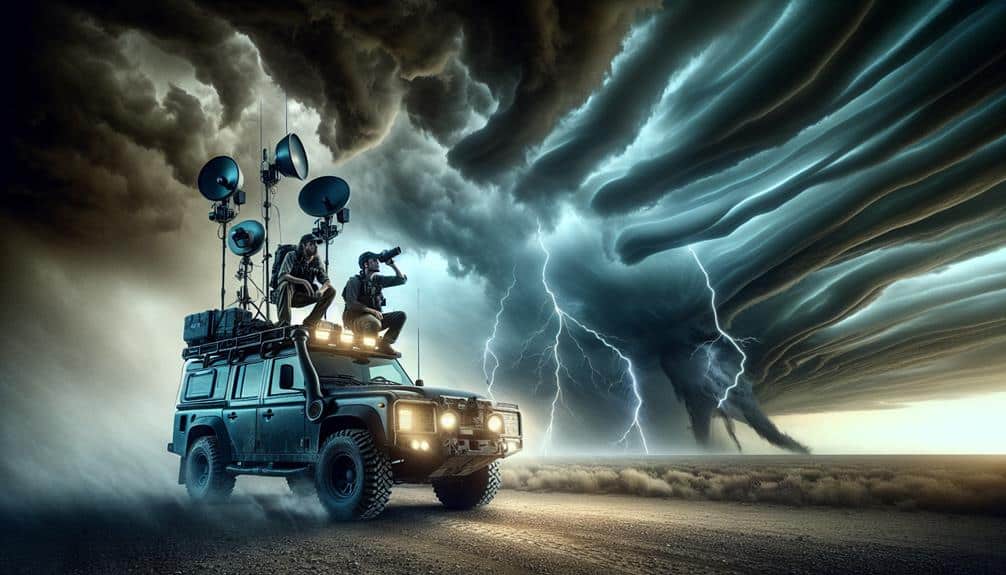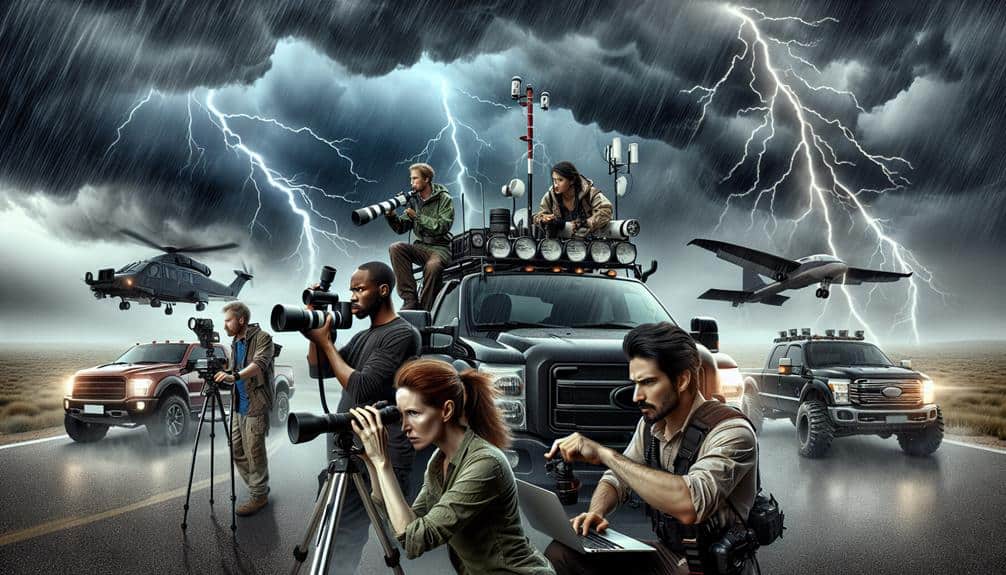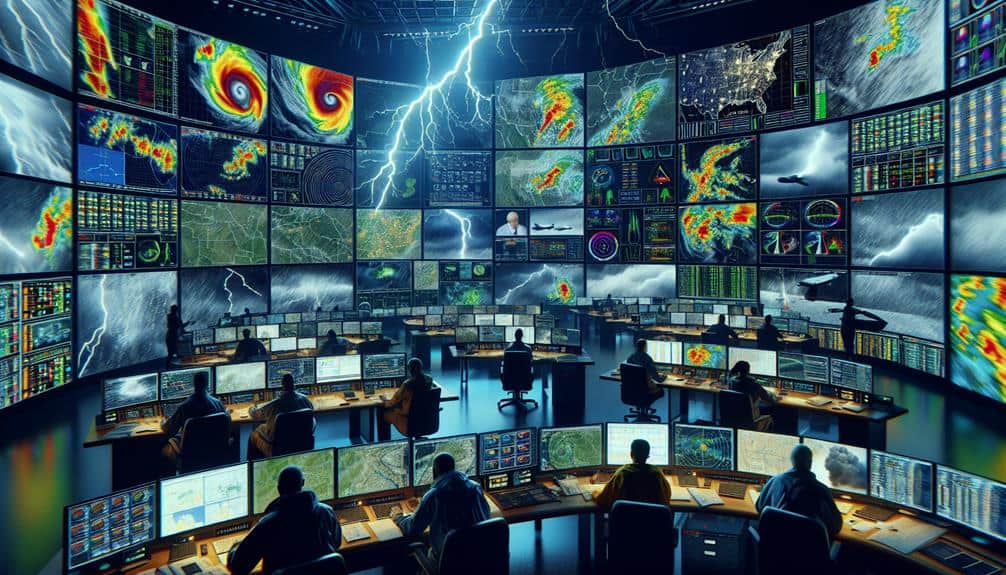We've gathered insights from the top 10 storm chaser photographers who reveal their mastery in capturing nature's fury. They emphasize the importance of understanding weather patterns, using specialized gear, and maintaining safety while pursuing storms. Their techniques include setting up tripods for sharp lightning shots, timing captures during golden hours, and collaborating with meteorologists for accurate data. These experts prioritize ethical practices and community engagement while maneuvering through intense weather conditions. They share the challenges and exhilaration of documenting raw storms, offering us a glimpse into their awe-inspiring experiences. Discover their unique perspectives and expert tips on storm chasing photography.
Key Points
- Top storm chasers highlight the importance of precise timing and weather pattern understanding for perfect shots.
- Utilization of long exposure techniques and advanced equipment is critical for capturing multiple lightning bolts and dynamic storm scenes.
- Real-time radar and GPS tracking systems are essential tools for safety and strategic positioning during storm chases.
- Collaborating with meteorologists enhances predictive accuracy and provides vital real-time updates for storm chasing decisions.
Understanding Storm Spotting Networks
Storm spotting networks are essential systems that enable storm chasers to share real-time weather data and observations. These networks facilitate a collaborative environment where we can enhance community support and adhere to safety protocols. By communicating our findings, we help local authorities and the general public stay informed and safe during severe weather events.
Maintaining proper storm chasing etiquette is pivotal in these networks. We must respect fellow chasers and avoid interfering with emergency responders. Clear communication strategies are vital for effective coordination. Using standardized terminology and reliable channels ensures that our observations are accurate and timely.
Our participation in storm spotting networks isn't just about the thrill of the chase; it's about contributing to a broader safety net. These networks allow us to provide crucial information that can save lives and minimize property damage. Ensuring that we follow established safety protocols not only protects us but also enhances the credibility and reliability of the data we share.
In essence, storm spotting networks empower us through community support and effective communication. By adhering to storm chasing etiquette and maintaining rigorous safety protocols, we make a meaningful impact in the field of severe weather observation.
The Art of Storm Photography
In our pursuit of storm photography, we focus on capturing lightning strikes, framing dramatic skies, and timing the perfect shot. These elements require keen observation and quick reflexes.
Let's explore the techniques that make these moments possible.
Capturing Lightning Strikes
Photographing lightning strikes demands precise timing and an understanding of weather patterns to capture the fleeting beauty of these natural phenomena. We must anticipate the movement of the storm and position ourselves in the most favorable location to achieve a compelling lightning composition. The objective is to emphasize the storm atmosphere while making the electrifying moments stand out.
For best results, we employ long exposure techniques to capture the energy of multiple lightning bolts in a single frame. This approach enables us to portray the intensity and dynamic nature of storms. Having a tripod and a remote shutter release is vital to minimize camera shake, ensuring sharp, detailed images.
Understanding the storm's behavior is critical. By analyzing weather maps and utilizing real-time radar, we can anticipate where lightning is most likely to strike. Safety is of utmost importance, so maintaining a safe distance from the storm is crucial while still being close enough to capture the desired shot.
Framing Dramatic Skies
Capturing the grandeur of dramatic skies requires a keen eye for composition and an understanding of the interplay between light and weather elements. When we frame stormy horizons, we focus on dramatic lighting and contrast to highlight the sheer power and beauty of nature. The key is to balance the elements within the frame, ensuring that the storm clouds, lightning, and landscape come together harmoniously.
We often use the rule of thirds to position the horizon and focal points, allowing the sky to dominate the frame. This technique not only emphasizes the vastness of the storm but also draws viewers into the scene. Dramatic lighting plays an essential role here; it can transform a simple cloud formation into a mesmerizing spectacle. By adjusting our exposure settings, we can accentuate the contrast between the dark storm clouds and any available light sources, such as the sun peeking through or lightning flashes.
Incorporating foreground elements, like trees or buildings, adds depth to our photos, giving a sense of scale to the stormy horizons. By carefully considering composition and lighting, we can capture the raw and untamed essence of storms in our photography.
Timing the Perfect Shot
Timing our shots precisely is necessary for capturing the most breathtaking moments in storm photography. We need to understand weather patterns to anticipate the exact moments when storms display their raw power. This means constantly monitoring radar data and forecasts to position ourselves strategically.
In terms of lighting conditions, we often shoot during the golden hour, just after sunrise or before sunset, when the light enhances the dramatic effect of storm clouds. However, we must also be prepared to adapt to sudden changes, as storms can create unique lighting scenarios.
Equipment choices play a vital role in our success. We rely on sturdy tripods to stabilize our cameras in high winds and use wide-angle lenses to capture the vastness of the stormy sky. Fast shutter speeds are essential for freezing lightning strikes, while long exposures can reveal the swirling dynamics of the storm.
Composition tips include focusing on elements like leading lines and foreground interest to add depth to our images. By combining our knowledge of weather patterns, lighting conditions, and the right equipment, we can time our shots to perfection, capturing the awe-inspiring beauty of nature's most powerful displays.
Essential Gear for Storm Chasers
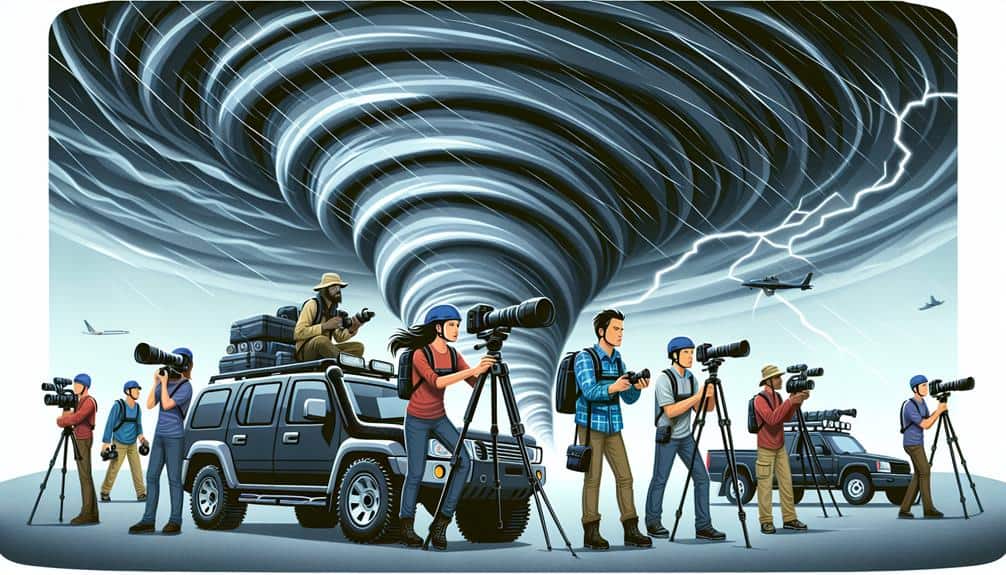
Every storm chaser needs reliable gear to guarantee both safety and effective documentation of weather phenomena.
First and foremost, our camera settings must be adaptable to rapidly changing light and weather conditions. We need cameras with manual controls for shutter speed, aperture, and ISO to capture the perfect shot in any scenario.
Equally important is protective gear for ourselves and our equipment—waterproof cases, rain covers, and sturdy tripods ensure our gear stays safe and functional.
Vehicle modifications are also essential. Our vehicles should be fitted with reinforced tires, extra fuel tanks, and advanced navigation systems to handle rough terrains and extended chases.
High-quality communication devices, such as two-way radios and satellite phones, keep us connected with our team and weather updates, even in remote areas where cell service is unreliable.
In addition to these essentials, having a first aid kit, extra batteries, and backup storage for our photos and videos is non-negotiable. A well-prepared storm chaser isn't only safer but also more efficient at capturing the awe-inspiring power of severe weather.
With the right gear and preparation, we can focus on the thrill of the chase and the freedom it brings.
While we're equipped with all the necessary gear, understanding how to safely navigate severe weather is vital for every storm chaser. Storm chaser partnerships play an important role in guaranteeing safety. By working together, we can share real-time information and support one another during high-risk situations.
It's important that we maintain constant weather awareness, monitoring radar updates and alerts to stay informed about changing conditions. Emergency preparedness is crucial. We should have a well-thought-out plan that includes evacuation routes, first aid supplies, and communication devices.
Knowing when to retreat is just as significant as knowing when to advance. Risk evaluation is a continuous process; we must evaluate the potential hazards at each stage of our chase. This includes evaluating road conditions, storm intensity, and proximity to danger zones.
We can't control the weather, but we can control our response to it. By prioritizing safety over thrill, we increase our chances of capturing stunning images without compromising our well-being. Collaboration, vigilance, and preparedness form the backbone of successful storm chasing.
Let's use our skills and knowledge to chase responsibly and make sure that we return safely from every adventure.
Capturing Lightning Strikes
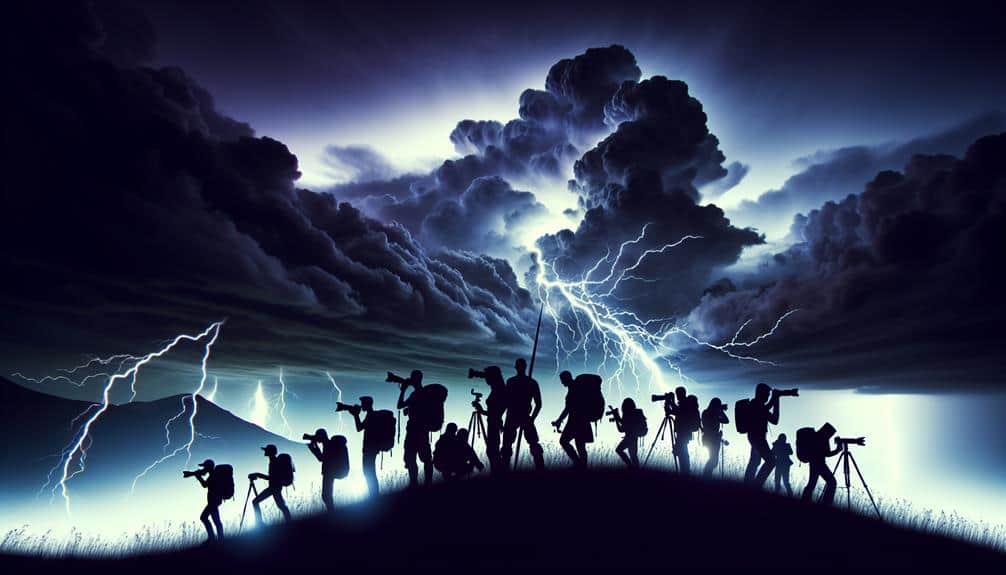
Capturing lightning strikes requires impeccable timing and precision, which we achieve through specialized techniques and equipment. We must also prioritize safety to avoid the inherent dangers of storm chasing.
Let's explore the best practices for photographing these electrifying moments while staying safe.
Timing and Precision
Timing and precision are pivotal for storm chaser photographers aiming to capture the perfect lightning strike. We rely on these elements to frame our shots with impeccable lightning composition, ensuring each photograph tells a powerful story.
Understanding weather patterns is essential; it allows us to predict when and where lightning is most likely to occur. To capture lightning effectively, we need to be in the right place at the right time. This involves studying meteorological data and real-time radar images to gauge storm movements. By identifying key weather patterns, we can position ourselves ideally to photograph the electrifying moments.
Our equipment also plays a key role. We use high-speed cameras and tripods to achieve stability and precision in our shots. The camera settings, particularly the shutter speed, must be meticulously adjusted to capture the fleeting brilliance of a lightning bolt.
Post-processing is another vital aspect. By enhancing the contrast and sharpness, we can bring out the intricate details of the lightning strikes, making our photographs stand out.
In this way, timing and precision aren't just about being there when lightning strikes; they're about capturing the essence of the moment in every frame.
Safety and Techniques
Ensuring safety is paramount when photographing lightning, as the unpredictability of storms poses significant risks. We must always prioritize safety first, techniques second. This means understanding the storm's behavior and maintaining a safe distance. It's essential to avoid open fields, tall structures, and bodies of water. Always have an escape plan and make sure your vehicle is accessible and ready to move.
Weather awareness is key. We should consistently monitor weather updates and storm forecasts. Using apps and radar systems helps us stay informed about storm movements and intensity. The more information we have, the better we can position ourselves safely while capturing the dramatic beauty of lightning.
When it comes to photography skills, setting up the camera correctly is vital. Use a sturdy tripod to keep the camera stable and set a low ISO to minimize noise. A wide aperture allows more light, and a longer exposure time increases the chances of capturing a strike. We often utilize a remote shutter release to avoid camera shake.
Techniques for Tornado Photography
Mastering tornado photography demands a combination of specialized equipment, precise timing, and an understanding of storm behavior. When chasing tornadoes, we must anticipate their movement and position ourselves strategically. This often involves extensive knowledge of meteorology and the use of advanced tools like radar and GPS. Our primary goal is to capture nature's raw power while maintaining a safe distance.
High-quality cameras with fast shutter speeds and wide apertures are essential for clear, detailed shots. We often use tripods to stabilize our cameras, ensuring sharp images despite the turbulent environment. Telephoto lenses allow us to capture the tornado's intricate details from a safer distance, while wide-angle lenses help portray the vastness of the storm.
Lighting plays a crucial role. Typically, natural light during a storm can be unpredictable. Adjusting ISO settings and exposure can help manage varying light conditions. We also rely on bracketing techniques to ensure the best exposure.
Timing is everything. We often take multiple shots in rapid succession to capture the tornado's evolution. Post-processing helps enhance the images, but the essence of our work lies in being at the right place at the right time and having the skill to seize the moment.
Sharing Real-Time Data
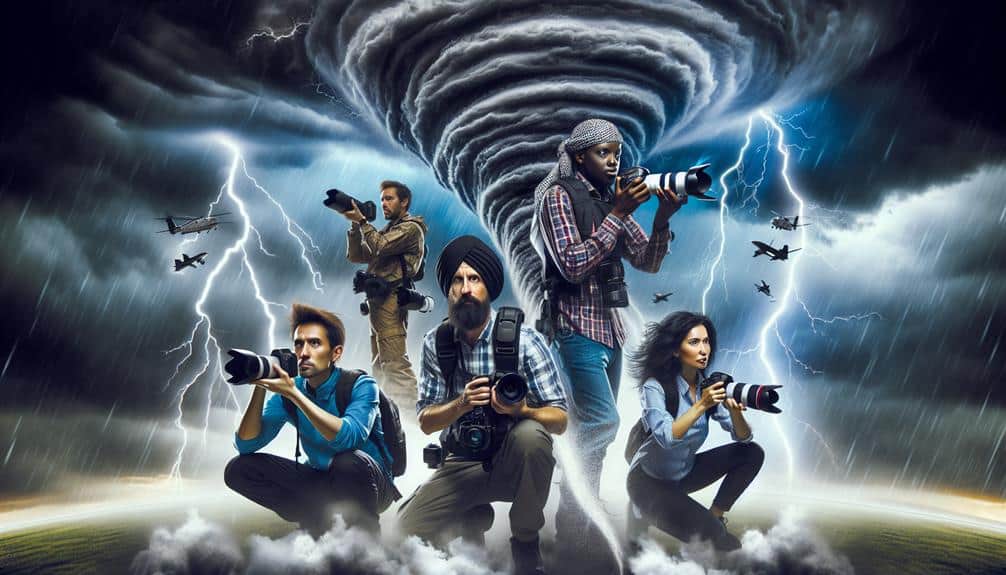
During our storm-chasing expeditions, we prioritize sharing real-time data with meteorologists and fellow chasers to enhance safety and improve forecasting accuracy. We rely on advanced technology to provide live updates and storm tracking information, ensuring everyone involved stays informed about rapidly changing weather conditions.
Our vehicles are equipped with high-resolution cameras and broadcasting equipment to capture real-time footage of storms. This footage is essential for monitoring storm development and predicting potential paths. By streaming this data live, we offer valuable insights that can be used for immediate decision-making and long-term research.
We also use GPS tracking systems to share our exact location with other storm chasers. This allows for coordinated efforts and reduces the risk of overlapping paths, which can be dangerous. Additionally, sharing our position helps meteorologists to cross-reference data from multiple sources, improving the accuracy of weather models.
Through social media platforms and specialized apps, we disseminate our findings to the broader community. These updates include detailed reports on weather conditions, storm intensity, and safety advisories. By providing this information in real-time, we empower individuals to make informed decisions, ultimately enhancing public safety and expanding our collective understanding of storm behavior.
Collaborating With Meteorologists
Our partnership with meteorologists is essential for interpreting storm data and enhancing predictive models. We work closely with them to make sure that the information we gather in the field is accurately analyzed and incorporated into broader weather forecasts. This collaboration allows us to refine our chasing strategies and utilize advanced storm tracking techniques, making our efforts more effective and safe.
Forecast collaboration is necessary. Meteorologists provide us with critical real-time updates that inform our decisions about where and when to chase storms. Their expertise in data interpretation helps us understand the complex dynamics of storm systems, leading to more reliable predictions.
In return, our firsthand observations and photographic evidence give meteorologists valuable insights into the behavior of storms, which can be used to improve predictive models.
Ethical Storm Chasing Practices
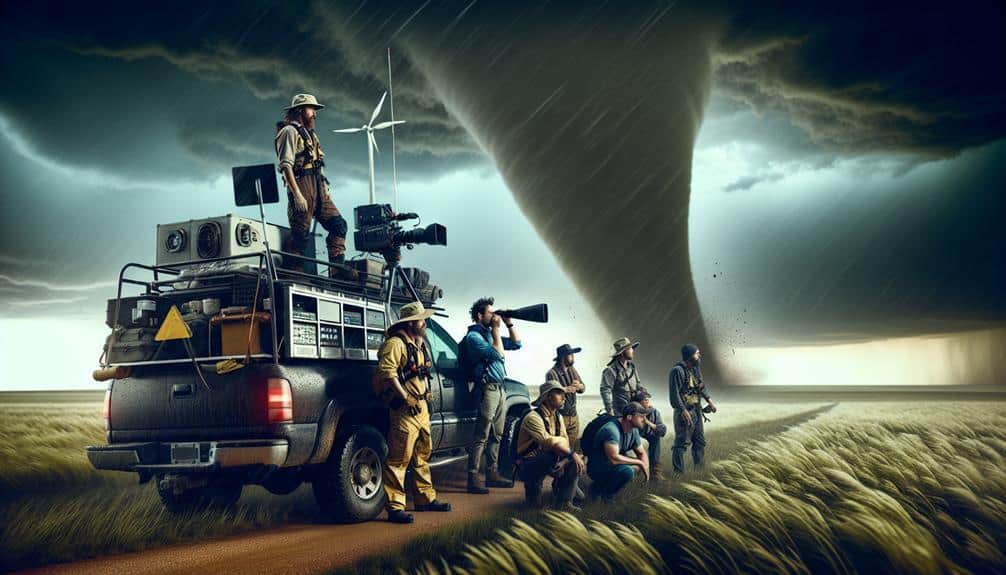
When chasing storms, we must follow ethical practices to guarantee both our safety and the well-being of the communities we encounter. Adhering to these principles helps us minimize our environmental impact and contribute positively to conservation efforts. We need to avoid disturbing natural habitats and ensure our presence doesn't exacerbate the challenges faced by local flora and fauna.
Responsible tourism plays a pivotal role in our storm-chasing endeavors. By respecting local regulations and engaging with the communities we visit, we can foster goodwill and cooperation. Community engagement is essential; it ensures that we're not just passing through but also contributing to the areas we explore. Offering assistance during recovery efforts or educating locals about storm preparedness can make a significant difference.
Moreover, we should always prioritize safety, avoiding actions that could endanger ourselves or others. This includes staying informed about weather conditions, adhering to warnings, and not interfering with emergency services.
Inspiring Stories From the Field
Let's explore some inspiring stories from the field that highlight our heart-pounding close encounters, capturing nature's fury, and experiencing unexpected moments afield.
These experiences not only test our skills but also deepen our appreciation for the forces we photograph. Each story underscores the unique challenges and rewards of storm chasing.
Heart-Pounding Close Encounters
In the midst of chasing storms, we often find ourselves face-to-face with nature's raw power, capturing breathtaking moments that few ever witness firsthand. These heart-stopping moments deliver an adrenaline rush unlike any other.
Racing against time, we navigate through intense weather conditions, all in pursuit of the perfect shot.
One such encounter occurred last spring in the Great Plains. As we positioned ourselves, a supercell thunderstorm began to take shape, its ominous, churning clouds casting shadows over the vast landscape. The sky darkened, and the wind picked up speed, creating an atmosphere charged with electricity. The storm's rotation became more defined, signaling the potential for a tornado.
We watched in awe as a funnel began to descend, spiraling towards the earth. It was a scene of both beauty and danger, the breathtaking landscape framing this powerful force of nature. The intensity of the moment was palpable, every sense heightened as we documented the unfolding spectacle.
Such experiences remind us why we chase storms. It's not just about the thrill; it's about witnessing the raw, untamed power of nature and capturing it for the world to see.
Capturing Nature's Fury
Our journey to capture nature's fury has led to some of the most inspiring and unforgettable moments in our careers. Each storm chase brings a unique blend of storm chaser camaraderie and adrenaline rush, as we band together to document the raw, unfiltered power of nature. We're often reminded of how small we're in the face of such immense forces, yet it's that very realization that motivates us.
We've seen nature's power in its most dramatic forms—massive supercells, intense lightning storms, and swirling tornadoes. These phenomena, while dangerous, reveal an artistic beauty that we aim to capture through our lenses. The contrast between dark, ominous clouds and the occasional burst of sunlight creates a visual symphony that's both haunting and mesmerizing.
As storm chasers, we don't just chase storms; we pursue the perfect shot that encapsulates the essence of these natural events. Each photograph tells a story of resilience and awe, capturing moments that most people only see from the safety of their homes.
The camaraderie among us makes these experiences even more rewarding, as we share both the challenges and triumphs of our unique profession.
Unexpected Moments Afield
Every storm chase has its share of unexpected moments that turn into unforgettable stories from the field. Often, we find ourselves in awe of nature's unpredictability. One moment, we're tracking a storm, and the next, we witness a scene of unexpected beauty. These fleeting moments, where the raw power of a storm juxtaposes with serene vistas, are what we live for.
We've experienced nature's unpredictability firsthand. There was a time when we were chasing what seemed like a standard thunderstorm. Suddenly, the sky transformed, and a double rainbow appeared against the backdrop of ominous clouds. It was a fleeting moment, but we captured it. The raw power of the storm combined with the unexpected beauty of the rainbow created a once-in-a-lifetime photograph.
On another chase, we encountered a lightning storm so intense that the sky seemed to crack open with each bolt. The storm's raw power was mesmerizing. Amidst the chaos, we caught a brief, serene moment where the landscape was illuminated, showcasing nature's duality.
These stories remind us why we chase. It's about embracing nature's unpredictability and seizing those fleeting moments of unexpected beauty.
Frequently Asked Questions
How Do Storm Chasers Stay Updated on Changing Weather Conditions in Real-Time?
We stay updated on changing weather conditions in real-time by using satellite technology and radar systems. These tools provide us with accurate, up-to-the-minute information, helping us make informed decisions and chase storms safely.
What Are the Most Common Challenges Faced by Storm Chasers During Expeditions?
We often face equipment maintenance issues, safety protocols adherence, communication breakdowns, and traffic congestion during our expeditions. These challenges can hinder our progress, but we adapt and overcome to capture the storm's raw beauty.
How Do Storm Chasers Manage Their Mental and Physical Well-Being on the Road?
We weather the storm by embracing mindfulness practices and stress relief. Our exercise routines and healthy diet keep us physically sharp. This harmony of body and mind guarantees we thrive on the open road, chasing freedom.
Are There Any Specific Regions That Are More Popular for Storm Chasing?
We often chase storms in the Midwest, particularly in Tornado Alley. These regions offer prime conditions for severe weather, making them popular among storm chasers seeking to witness and document powerful tornadoes and supercells.
What Are the Legal Considerations for Storm Chasers in Different States or Countries?
Exploring storm chasing is like sailing through uncharted waters. We must consider liability risks and insurance requirements. Permission needed and privacy laws vary by location. Understanding these factors guarantees we respect boundaries and stay safe.
